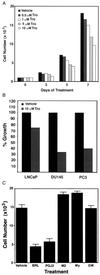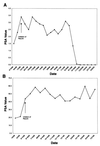Effects of ligand activation of peroxisome proliferator-activated receptor gamma in human prostate cancer - PubMed (original) (raw)
Clinical Trial
. 2000 Sep 26;97(20):10990-5.
doi: 10.1073/pnas.180329197.
M Smith, P Sarraf, T Kroll, A Aiyer, D S Kaufman, W Oh, G Demetri, W D Figg, X P Zhou, C Eng, B M Spiegelman, P W Kantoff
Affiliations
- PMID: 10984506
- PMCID: PMC27136
- DOI: 10.1073/pnas.180329197
Clinical Trial
Effects of ligand activation of peroxisome proliferator-activated receptor gamma in human prostate cancer
E Mueller et al. Proc Natl Acad Sci U S A. 2000.
Abstract
Peroxisome proliferator-activated receptor gamma (PPARgamma) is a nuclear hormone receptor that plays a key role in the differentiation of adipocytes. Activation of this receptor in liposarcomas and breast and colon cancer cells also induces cell growth inhibition and differentiation. In the present study, we show that PPARgamma is expressed in human prostate adenocarcinomas and cell lines derived from these tumors. Activation of this receptor with specific ligands exerts an inhibitory effect on the growth of prostate cancer cell lines. Further, we show that prostate cancer and cell lines do not have intragenic mutations in the PPARgamma gene, although 40% of the informative tumors have hemizygous deletions of this gene. Based on our preclinical data, we conducted a phase II clinical study in patients with advanced prostate cancer using troglitazone, a PPARgamma ligand used for the treatment of type 2 diabetes. Forty-one men with histologically confirmed prostate cancer and no symptomatic metastatic disease were treated orally with troglitazone. An unexpectedly high incidence of prolonged stabilization of prostate-specific antigen was seen in patients treated with troglitazone. In addition, one patient had a dramatic decrease in serum prostate-specific antigen to nearly undetectable levels. These data suggest that PPARgamma may serve as a biological modifier in human prostate cancer and its therapeutic potential in this disease should be further investigated.
Figures
Figure 1
PPARγ is expressed in human normal prostate, carcinomas, and cell lines. Expression of PPARγ mRNA in (A) samples from five patients (from A to E), obtained from normal prostate tissue (N), neighboring carcinomas (T), and (B) in LNCaP, DU145, and PC3 prostate cancer cell lines and colon cancer cells (Moser), used as control. (C) PPARγ protein levels in LNCaP, DU145, and PC3 cells.
Figure 2
PPARγ activation inhibits cell growth in prostate cancer cell lines. (A) Time course and dose-response inhibition of cell growth of DU145 treated with troglitazone. (B) Comparison of the growth inhibitory effects of troglitazone at 10 μM in LNCaP, DU145, and PC3 cells. (C) Growth inhibition in DU145 cells treated for 7 days with 5 μM rosiglitazone (BRL) and 5 μM 15-deoxy-Δ12,14PGJ2 (PGJ2). DU145 treated with 10 μM M2, an inactive metabolite of troglitazone, 10 μM of Wy, or 5 μM of GW 00233, PPARα and PPARδ ligands, respectively, did not show any growth inhibition compared with troglitazone-treated cells.
Figure 3
PSA levels are decreased by troglitazone in vitro. LNCaP cells show decreased levels of PSA after treatment with different doses of troglitazone compared with vehicle-treated cells.
Figure 4
PSA levels are modulated by troglitazone in prostate cancer patients. The PSA levels of prostate cancer patients, treated with 800 mg of troglitazone/day, were measured every 4 weeks. (A) The patient received radiation therapy in 11/94, nadir of 0.1. (B) Patient had post radiation therapy nadir of 1.9 on 6/2/94.
Similar articles
- Ligand for peroxisome proliferator-activated receptor gamma (troglitazone) has potent antitumor effect against human prostate cancer both in vitro and in vivo.
Kubota T, Koshizuka K, Williamson EA, Asou H, Said JW, Holden S, Miyoshi I, Koeffler HP. Kubota T, et al. Cancer Res. 1998 Aug 1;58(15):3344-52. Cancer Res. 1998. PMID: 9699665 - Down-Regulation of prostate-specific antigen expression by ligands for peroxisome proliferator-activated receptor gamma in human prostate cancer.
Hisatake JI, Ikezoe T, Carey M, Holden S, Tomoyasu S, Koeffler HP. Hisatake JI, et al. Cancer Res. 2000 Oct 1;60(19):5494-8. Cancer Res. 2000. PMID: 11034093 - Ligands for peroxisome proliferator-activated receptor gamma inhibit growth and induce apoptosis of human papillary thyroid carcinoma cells.
Ohta K, Endo T, Haraguchi K, Hershman JM, Onaya T. Ohta K, et al. J Clin Endocrinol Metab. 2001 May;86(5):2170-7. doi: 10.1210/jcem.86.5.7493. J Clin Endocrinol Metab. 2001. PMID: 11344222 - Peroxisome proliferator-activated receptor gamma (PPargamma) as a novel target for prostate cancer.
Smith MR, Kantoff PW. Smith MR, et al. Invest New Drugs. 2002 May;20(2):195-200. doi: 10.1023/a:1015670126203. Invest New Drugs. 2002. PMID: 12099579 Review. - Treatment of insulin resistance with peroxisome proliferator-activated receptor gamma agonists.
Olefsky JM. Olefsky JM. J Clin Invest. 2000 Aug;106(4):467-72. doi: 10.1172/JCI10843. J Clin Invest. 2000. PMID: 10953021 Free PMC article. Review. No abstract available.
Cited by
- Commonalities in the Association between PPARG and Vitamin D Related with Obesity and Carcinogenesis.
Bandera Merchan B, Tinahones FJ, Macías-González M. Bandera Merchan B, et al. PPAR Res. 2016;2016:2308249. doi: 10.1155/2016/2308249. Epub 2016 Aug 8. PPAR Res. 2016. PMID: 27579030 Free PMC article. Review. - The insulin receptor: a new target for cancer therapy.
Malaguarnera R, Belfiore A. Malaguarnera R, et al. Front Endocrinol (Lausanne). 2011 Dec 6;2:93. doi: 10.3389/fendo.2011.00093. eCollection 2011. Front Endocrinol (Lausanne). 2011. PMID: 22654833 Free PMC article. - Effects of PPARγ Ligands on Leukemia.
Tabe Y, Konopleva M, Andreeff M, Ohsaka A. Tabe Y, et al. PPAR Res. 2012;2012:483656. doi: 10.1155/2012/483656. Epub 2012 May 21. PPAR Res. 2012. PMID: 22685453 Free PMC article. - PPAR gamma, bioactive lipids, and cancer progression.
Robbins GT, Nie D. Robbins GT, et al. Front Biosci (Landmark Ed). 2012 Jan 1;17(5):1816-34. doi: 10.2741/4021. Front Biosci (Landmark Ed). 2012. PMID: 22201838 Free PMC article. Review. - Peroxisome proliferation-activated receptor δ agonist GW0742 interacts weakly with multiple nuclear receptors, including the vitamin D receptor.
Nandhikonda P, Yasgar A, Baranowski AM, Sidhu PS, McCallum MM, Pawlak AJ, Teske K, Feleke B, Yuan NY, Kevin C, Bikle DD, Ayers SD, Webb P, Rai G, Simeonov A, Jadhav A, Maloney D, Arnold LA. Nandhikonda P, et al. Biochemistry. 2013 Jun 18;52(24):4193-203. doi: 10.1021/bi400321p. Epub 2013 Jun 10. Biochemistry. 2013. PMID: 23713684 Free PMC article.
References
- Kliewer S A, Lenhard J M, Willson T M, Patel I, Morris D C, Lehmann J M. Cell. 1995;83:813–819. - PubMed
- Forman B M, Tontonoz P, Chen J, Brun R P, Spiegelman B M, Evans R M. Cell. 1995;83:803–812. - PubMed
- Lehmann J M, Moore L B, Smith-Oliver T A, Wilkison W O, Willson T M, Kliewer S A. J Biol Chem. 1995;270:12953–12956. - PubMed
- Spiegelman B M. Diabetes. 1998;47:507–514. - PubMed
Publication types
MeSH terms
Substances
LinkOut - more resources
Full Text Sources
Other Literature Sources
Medical
Molecular Biology Databases



